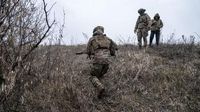Ukrainian troops have launched a series of offensive operations in the Russian oblast of Belgorod, marking a significant escalation in the ongoing conflict that emerged in early 2022. The first of these assaults took place on March 18, 2025, near Demidovka, situated close to the border with the Kursk region. Reports suggest that the attacks continued throughout March 18 and into March 19, as the Ukrainian forces pushed deeper into Russian territory.
The Institute for the Study of War reported that Ukrainian troops advanced approximately one kilometer into Russian territory, covering an area about five kilometers wide. Despite these gains being described as “small advances,” the operations did breach a small Russian defense line located at the border in certain areas. This slight territorial gain is characterized as noteworthy given the persistent stalemate observed since previous military encounters.
Media reports have emerged confirming these incidents, with officials acknowledging the intensity of the situation. Viatcheslav Gladkov, governor of the Belgorod oblast, remarked on March 19 that the circumstances were “difficult” for Russian forces, suggesting a notable response from the Kremlin. This marks a continuation of tensions as Russian officials were constrained to recognize the effective incursions by Ukraine.
Previous to these offensives, Ukrainian forces had seen mixed results. The region of Kursk had experienced a similar situation after a brief offensive in August 2024, while most of the occupied territory witnessed a regaining of control by Russian troops during February and March 2025. However, the current engagement in Belgorod serves as a reminder of Ukraine's strategic aims despite recent setbacks.
Ukrainian President Volodymyr Zelensky discussed the challenges faced from Russian troop movements, indicating an imminent threat along the border regions. In a statement released on March 18, he noted, “We have observed a new strengthening of troops [from Russia] along the border with the region of Sumy.” He emphasized that Ukrainian troops would not back down easily amid these confrontations.
Simultaneously, analysts suggest that these incursions are a deeply strategic decision, influenced by the ongoing shifts in military positions and the drawn-out negotiations between Russia and the United States regarding a ceasefire. The complexity of geopolitical pressures surrounding this confrontation has undoubtedly shaped Kiev’s operational tactics as they seek to strengthen their bargaining position.
Reports from various sources indicate that these Ukrainian maneuvers align with military observations recorded on platforms like Telegram. Commentators noted that three infantry groups, aided by tanks and specialized demining equipment, executed these assaults. Such preparedness highlights the ongoing logistical evolutions within the Ukrainian military, adapting to confront the heavily fortified and mined Russian border.
Despite claims by Russian officials that these advances were largely repelled, with assertions of significant Ukrainian losses, including reported destruction of a tank and numerous armored vehicles, a clearer picture of the border engagements continues to materialize. The Ministry of Defense stated that they inflicted up to sixty losses within the Ukrainian ranks during this series of assaults.
As combat continues in the Belgorod oblast, drone strikes and artillery fire indicate that the situation remains volatile. Recent footage circulating on social media demonstrates the active resistance both sides are putting forth, underscoring the fragility of any negotiations on the horizon.
The tension in the region has also catalyzed evacuation efforts in certain districts of Belgorod, reflecting the rising dangers associated with continuous military engagements. As the uncertainty persists, the local population bears the brunt of these hostilities, with lives markedly disrupted by the fighting that penetrates their communities.
Experts are pondering the potential outcomes from these new developments, questioning if the Ukrainian incursions could create a leverage point in negotiations seeking a ceasefire. As both governments assert their military strength, this conflict illustrates the ongoing struggle for territorial integrity and sovereignty amidst an increasingly complicated political landscape.
The future remains uncertain as military actions from both Ukraine and Russia evoke critical responses. Each tactical decision will likely reverberate through international dialogues, as the involved nations consider the implications of military strategy on broader diplomatic efforts.


